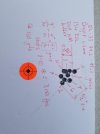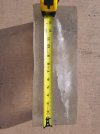Axl
Well-Known Member
Possibly, but throughout many results I have witnessed, they preform very well as is. Including a 5 yr old Shiras moose double lung @ 276 yds w/ 180 HVLD out of a 28 Nos. that dropped stone dead in his tracks. Bullet jacket was found under the off side hide. It was the only moose out of many I have seen drop instantly with a lung shot. Have seen the same terminal performance on deer and elk with that bullet and the 30 cal 215. This past season I shot a big whitetail buck at 691 yds quartering away. Deer dropped in his tracks entire chest cavity was jello soup. entrance wound was about 1" bullet did not exit. 215 Berger 30 Nos. velo. at impact aprox. 2300 fps.The best rework you could do to enhance berger bullet terminal performance is to turn a groove partially through the jacket on the ogive.
Devastating.
Vld style bullets go unstable and tumble inside an animal. Usually breaking off the nose. The scoring ensures this behavior.
Smashing bone also helps, but can't be guaranteed.
So all I do is check to be sure the tips are not plugged with polishing media


